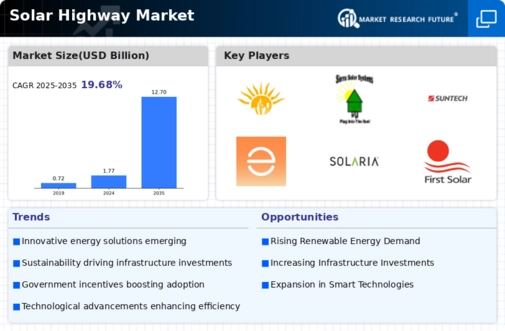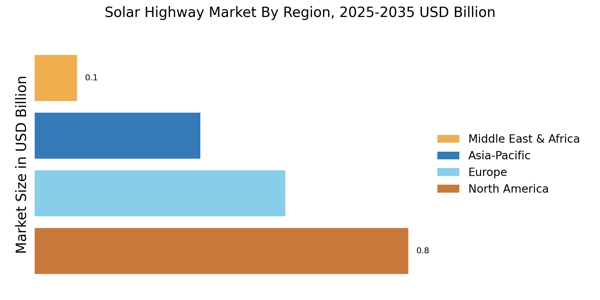Rising Energy Demand
The Solar Highway Market is significantly influenced by the rising demand for energy across various sectors. As urbanization continues to expand, the need for sustainable energy solutions becomes increasingly critical. The transportation sector, in particular, is seeking innovative ways to meet energy needs while reducing carbon footprints. Solar highways present a viable solution, as they can generate electricity while serving as functional roadways. Recent estimates suggest that the energy generated from solar highways could potentially power thousands of homes, thereby addressing energy shortages. This growing demand for renewable energy sources is likely to propel the Solar Highway Market to new heights.
Public Awareness and Acceptance
Public awareness and acceptance of renewable energy solutions are crucial drivers for the Solar Highway Market. As communities become more informed about the benefits of solar energy, there is a growing demand for sustainable infrastructure. Educational campaigns and community engagement initiatives are fostering a positive perception of solar highways, highlighting their potential to reduce greenhouse gas emissions and enhance energy independence. This shift in public sentiment is encouraging policymakers and stakeholders to invest in solar highway projects, thereby accelerating the growth of the Solar Highway Market. The increasing acceptance of solar technologies is likely to create a favorable environment for future developments.
Government Incentives and Policies
The Solar Highway Market is experiencing a surge in growth due to favorable government incentives and policies aimed at promoting renewable energy. Various countries have implemented tax credits, grants, and subsidies to encourage the adoption of solar technologies in infrastructure projects. For instance, the implementation of renewable energy mandates has led to an increase in funding for solar highway initiatives. As a result, public-private partnerships are becoming more common, facilitating the integration of solar energy into highway systems. This trend is expected to continue, with governments likely to enhance their support for solar infrastructure, thereby driving the Solar Highway Market forward.
Technological Innovations in Solar Energy
Technological advancements are playing a pivotal role in shaping the Solar Highway Market. Innovations in solar panel efficiency, energy storage solutions, and smart grid technologies are enhancing the feasibility and attractiveness of solar highways. For example, the development of transparent solar panels allows for the integration of solar technology into road surfaces without compromising aesthetics. Furthermore, advancements in energy storage systems enable the efficient use of generated solar power, making it available during peak demand times. These innovations not only improve the performance of solar highways but also contribute to the overall growth of the Solar Highway Market.
Integration with Transportation Infrastructure
The integration of solar technology with existing transportation infrastructure is a key driver for the Solar Highway Market. As governments and municipalities seek to modernize their transportation systems, the incorporation of solar highways offers a dual benefit: enhancing road functionality while generating renewable energy. This integration can lead to reduced maintenance costs and improved energy efficiency in transportation networks. Moreover, the potential for solar highways to power electric vehicle charging stations along major routes presents an attractive proposition for stakeholders. This synergy between solar energy and transportation infrastructure is expected to propel the Solar Highway Market into a new era of sustainable development.


















Leave a Comment